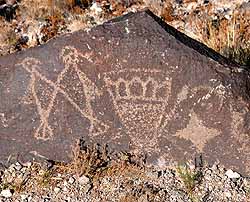
Petroglyph National Monument
As you walk the trails of Petroglyph National Monument, it seems as if voices, from the rocks, speak to tell the story of people who lived long ago, who walked the same ground, and left their legacy in images carved upon the black basaltic rocks. These images, and associated archeological sites along the Rio Grande, provide glimpses into a 12,000 year long story of human life in this area. This high desert is alive with sights and sounds - of a hawk that spirals down from the mesa top, a roadrunner that scurries into fragrant sage, and a desert millipede that traces waves in the sand. Desert plants also decorate the landscape, many of which were used by the Native Americans for food, medicine, dyes, and religious ceremonies.Petroglyph National Monument stretches 17 miles along Albuquerque's West Mesa, a volcanic basalt escarpment that dominates the city's western horizon. It contains 7,236 acres and protects a variety of cultural and natural resources including five volcanic cones, hundreds of archeological sites and an estimated 25,000 images carved by native peoples and early Spanish settlers. Many of the images are recognizable as animals, people, brands and crosses; others are more complex. Their meaning, possibly, understood only by the carver. These images are inseparable from the greater cultural landscape, from the spirits of the people who created them, and all who appreciate them.
Petroglyph National Monument is a place of respect, awe and wonderment.